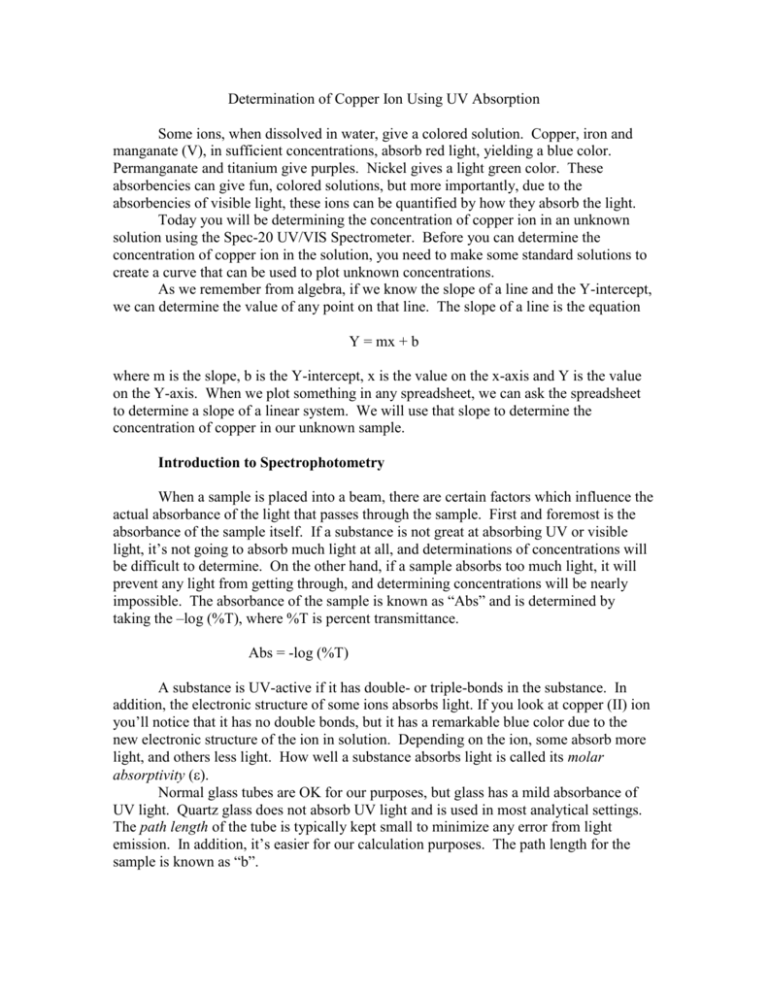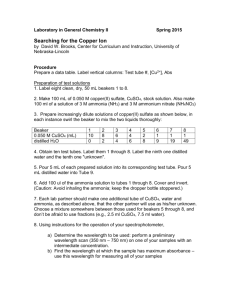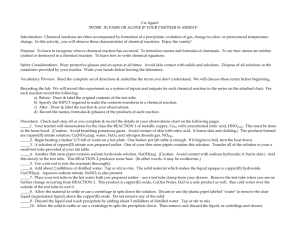Determination of Glucose in Blood Serum
advertisement

Determination of Copper Ion Using UV Absorption Some ions, when dissolved in water, give a colored solution. Copper, iron and manganate (V), in sufficient concentrations, absorb red light, yielding a blue color. Permanganate and titanium give purples. Nickel gives a light green color. These absorbencies can give fun, colored solutions, but more importantly, due to the absorbencies of visible light, these ions can be quantified by how they absorb the light. Today you will be determining the concentration of copper ion in an unknown solution using the Spec-20 UV/VIS Spectrometer. Before you can determine the concentration of copper ion in the solution, you need to make some standard solutions to create a curve that can be used to plot unknown concentrations. As we remember from algebra, if we know the slope of a line and the Y-intercept, we can determine the value of any point on that line. The slope of a line is the equation Y = mx + b where m is the slope, b is the Y-intercept, x is the value on the x-axis and Y is the value on the Y-axis. When we plot something in any spreadsheet, we can ask the spreadsheet to determine a slope of a linear system. We will use that slope to determine the concentration of copper in our unknown sample. Introduction to Spectrophotometry When a sample is placed into a beam, there are certain factors which influence the actual absorbance of the light that passes through the sample. First and foremost is the absorbance of the sample itself. If a substance is not great at absorbing UV or visible light, it’s not going to absorb much light at all, and determinations of concentrations will be difficult to determine. On the other hand, if a sample absorbs too much light, it will prevent any light from getting through, and determining concentrations will be nearly impossible. The absorbance of the sample is known as “Abs” and is determined by taking the –log (%T), where %T is percent transmittance. Abs = -log (%T) A substance is UV-active if it has double- or triple-bonds in the substance. In addition, the electronic structure of some ions absorbs light. If you look at copper (II) ion you’ll notice that it has no double bonds, but it has a remarkable blue color due to the new electronic structure of the ion in solution. Depending on the ion, some absorb more light, and others less light. How well a substance absorbs light is called its molar absorptivity (). Normal glass tubes are OK for our purposes, but glass has a mild absorbance of UV light. Quartz glass does not absorb UV light and is used in most analytical settings. The path length of the tube is typically kept small to minimize any error from light emission. In addition, it’s easier for our calculation purposes. The path length for the sample is known as “b”. Beer’s Law determines concentrations of materials in solutions (C) by comparing them to path length of the tube (b), the molar absorptivity () and absorbance (Abs). Abs = bC Procedure Observing the light Break into teams of 2. Go to the stations with the light emission devices and place a provided flash card at the beam exit. Notice the colors of the light as you cycle from 200 nm to 700 nm wavelength. Record the colors you see. Making your samples You are going to first determine what the best wavelength in the spec 20 is for your copper samples. Make a solution of copper by using a 5.00 mL pipet to transfer 5.00 mL of stock solution to a 50.00 mL volumetric flask. Dilute with distilled water to the 50.00 mL mark. Now, using a disposable Pasteur pipet, transfer 10.00 mL from your 50.00 mL dilute solution (in the volumetric flask) to your 10.00 mL graduated cylinder. Using the same pipet, transfer 1.00 mL to test tube 1, 2.00 mL to test tube 2, 3.00 mL to test tube 3, 4.00 to test tube 4 and 5.00 mL to test tube 5 (you will need to add 5.00 mL of your diluted stock to the graduated cylinder to fill test tube 5). Add 4.00 mL of distilled water to tube 1, 3.00 mL to tube 2, 2.00 mL to tube 3, and 1.00 mL to tube 4. Do not add any water to tube 5. Determining the maxima Before you can start measuring absorbance, you need to calibrate the spectrometer. Make sure the lid is closed and turn on the spectrometer. Tune the wavelength to 300 nm, and adjust the zero dial until the absorbance is 0. Now, insert a test tube with approximately 5 mL of distilled water into the spectrometer (this tube is called the “blank”). Adjust the %T until it hits 100%. Place test tube 5 into the Spec-20. Record the absorbance values in Excel, starting at 300 nm and increasing in 25 nm increments until you get to 675 nm. Record the absorbance at each wavelength and then graph it. NOTE: after each measurement, the spectrometer needs to be recalibrated with the empty cell and the blank! Constructing a calibration curve Set the spectrometer at 630 nm and calibrate the spectrometer. Insert tubes 1-5 and record the absorbances AND %T of each tube. Plot an XY scatter graph on Excel by concentration (mg/mL) versus absorbance and a separate graph using %T versus concentration. Add in a trendline and be sure to include the slope on the graph. Remember, molar absorptivity () is the slope of the line. Determining the concentration of Cu2+ in the unknown. The concentration of the copper in the unknown is a function of the absorbance of the unknown in the already-established Beer’s law plot from above. You can determine its concentration from the absorbance equation and average molar absorptivity. Graphs: For this lab you should turn in graphs of %T versus concentration and Abs versus concentration. The graphs need a trendline and the equation for the graph should be presented on the graph with proper units on the axis as well as a title. WORKSHEET: Name____________________________ Sec _______ 1. What is the color of the light at the following wavelengths? 350 nm _____ 450 nm ____ 550 nm _______ 650 nm _______ 2. Concentration of the stock solution Volume of the stock transferred Volume of distilled water added to volumetric Concentration of diluted solution ______________________ ______________________ ______________________ ______________________ 3. Maxima of copper ion solution Minima of copper ion solution ______________________ ______________________ 4. Concentration of stock Cu2+ in M Concentration of diluted Cu2+ in M ______________________ ______________________ 4. Concentration of test tubes, absorbance and %T: Tube 1 2 3 4 mg/mL 5 Unknown ????????? Abs %T 5. What is the molar absorbtivity of the solution? What is the molar transmitivity of the solution? ______________________ ______________________ 6. Abs of unknown sample Concentration of unknown sample (in mg/ml) %T of unknown sample Concentration of unknown sample (in mg/ml) ______________________ ______________________ ______________________ ______________________ (NOTE: Only use the concentration from the absorbance for your answer.) Questions: 7. Why would it be detrimental to have a highly concentrated solution for a maximum point? 8. Why isn’t the %T for the blank zero? 9. Why do we use absorbance, a logarithmic measurement, instead of %T, a linear measurement? What happens to the graph and the unknown values if we use %T? Stockroom prep for spectroscopy lab: Needed: 12 50.00 mL volumetric flasks 12 5.00 mL pipets with bulbs ~40 disposable Pasteur pipets and rubber bulbs 6 Spec-20’s with small test tube holders 4 unknown solutions of copper acetate ranging from 0.500 mg/mL to 2.5 mg/mL of copper ion concentration. 2.0 L of stock copper ion solution. Can be made from 150.665 g of copper(II) acetate * 1 H2O, 175.512 g of copper(II) nitrate*2.5 H2O, or 188.408 g of copper(II) sulfate * 5 H2O.




